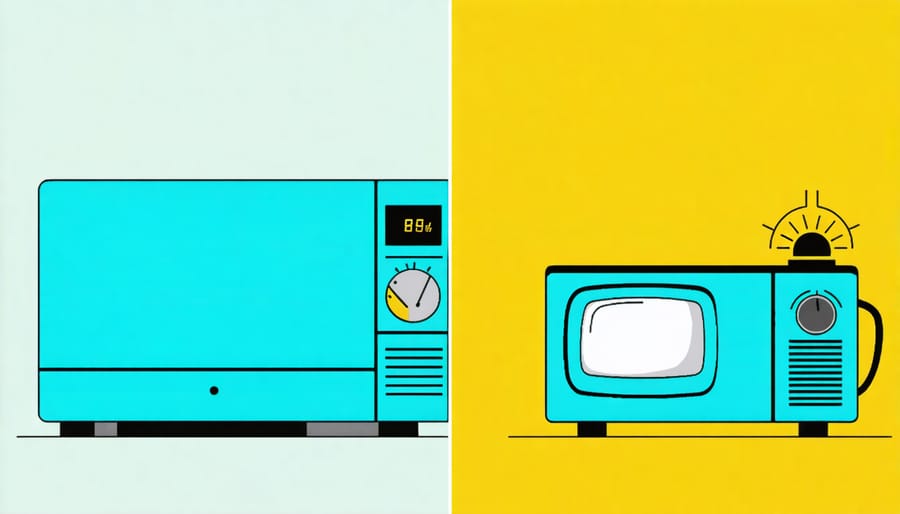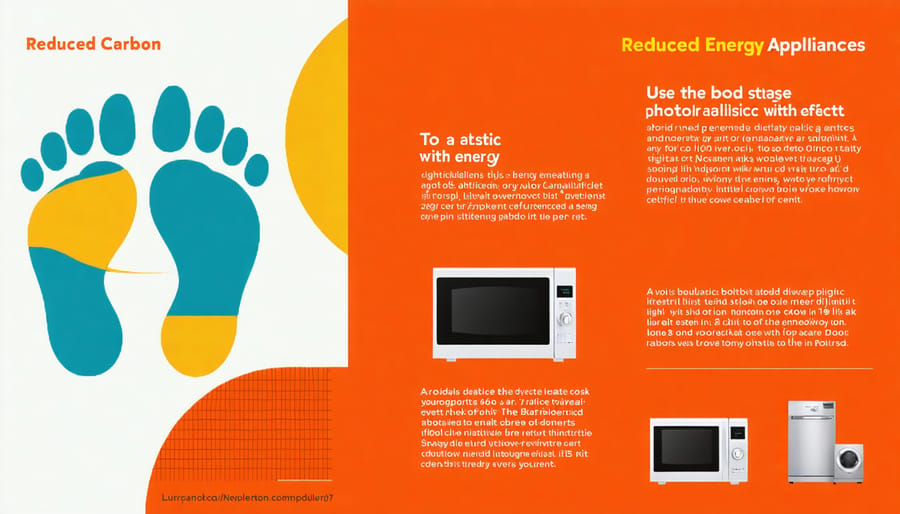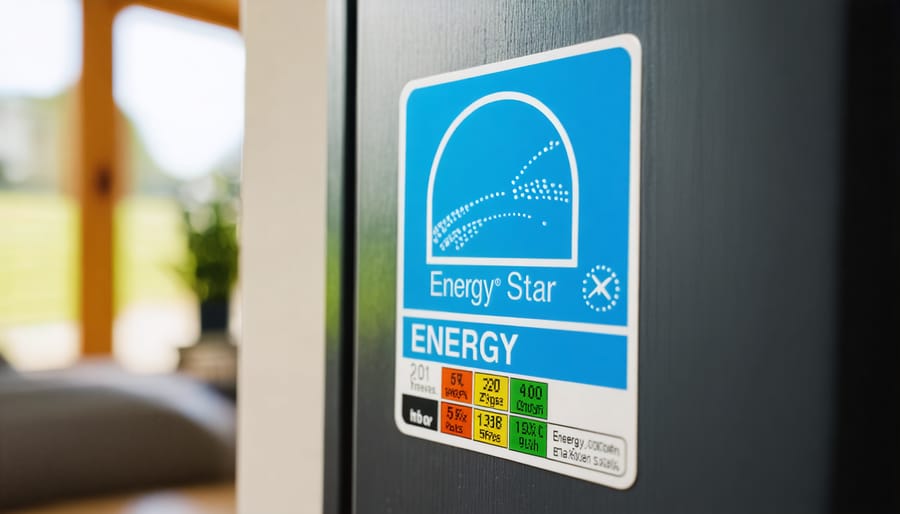Transform your home into an energy-saving powerhouse while slashing utility bills by upgrading to energy-efficient appliances. Modern ENERGY STAR certified devices consume up to 50% less electricity than their traditional counterparts, translating to average annual savings of $450 per household. Beyond the immediate financial benefits, these smart investments reduce your carbon footprint by approximately 4,000 pounds of greenhouse gas emissions yearly – equivalent to taking a car off the road for four months.
Homeowners who make the switch aren’t just saving money; they’re investing in cutting-edge technology that delivers superior performance. Today’s energy-efficient washers use 25% less electricity and 33% less water while actually cleaning clothes more effectively. Smart refrigerators adapt their cooling cycles to your usage patterns, maintaining optimal freshness while consuming minimal power. These innovations represent a win-win proposition: enhanced functionality paired with reduced environmental impact.
The decision to upgrade to energy-efficient appliances isn’t just about immediate savings – it’s about making a lasting investment in your home’s value and our planet’s future. With federal tax credits and local utility rebates often available, there’s never been a better time to make the switch to smarter, more sustainable home appliances.
The Real Financial Impact of Energy-Efficient Appliances
Initial Investment vs. Long-term Savings
While the upfront cost of energy-efficient appliances might seem steep, making smart investments in efficient appliances can lead to significant savings over time. Let’s break down the numbers to show you why this initial investment makes financial sense.
A typical energy-efficient refrigerator might cost $200-400 more than its standard counterpart, but it can save you $30-100 annually on electricity bills. This means you’ll recover the extra cost within 2-4 years, and everything after that is pure savings. The same principle applies to other major appliances – washing machines can save up to $50 per year, while dishwashers can reduce your water and energy bills by $25-40 annually.
Consider this: most quality appliances last 10-15 years. If you’re saving an average of $50 per year on each major appliance, that’s $500-750 in savings over its lifetime – and that’s just for one appliance! When you factor in rising energy costs, these savings could be even greater.
Don’t forget about available rebates and tax incentives. Many utility companies and government programs offer immediate rebates that can offset the higher purchase price, making the initial investment much more manageable. Some areas offer rebates of up to $500 for qualifying energy-efficient appliances, significantly reducing the payback period.

Energy Bill Analysis: Before and After
Let’s look at some real-world examples of how energy-efficient appliances can transform your monthly utility bills. Take the Smith family from Portland, who replaced their 15-year-old refrigerator with an ENERGY STAR certified model. Their monthly electricity costs dropped by $18 on average – that’s $216 in annual savings from just one appliance!
Another inspiring case comes from the Rodriguez household in Arizona. After switching their old washer, dryer, and dishwasher to energy-efficient models, they saw their utility bills decrease from $245 to $175 per month. That’s a whopping $840 saved per year!
Here’s what typical savings look like for common appliances:
– ENERGY STAR Refrigerator: $30-$100 annually
– Efficient Washing Machine: $50-$110 annually
– Modern Dishwasher: $25-$40 annually
– LED Light Bulbs: $50-$100 annually in total home savings
The Johnson family took a comprehensive approach, replacing all major appliances over two years. Their initial investment of $4,000 is now saving them approximately $1,200 annually – meaning their upgrades will pay for themselves in just over three years.
Remember, your actual savings will vary based on local utility rates, usage patterns, and the specific models you choose. Many homeowners report breaking even on their investment within 2-5 years, with all subsequent savings being pure profit.
Environmental Benefits That Matter
Making the switch to energy-efficient appliances isn’t just about saving money – it’s about making a real difference for our planet. When we choose these smart alternatives, we’re taking a significant step toward reducing our environmental footprint in ways that really add up over time.
Let’s look at the numbers: The average household’s appliances account for about 20% of its total energy consumption. By switching to energy-efficient models, you can reduce this energy usage by 10-50%, depending on the appliance. This reduction directly translates to lower greenhouse gas emissions, as less energy needed means less fossil fuel burned at power plants.
Consider your refrigerator, for instance. An ENERGY STAR certified model uses about 15% less energy than non-certified options, preventing roughly 890 pounds of greenhouse gas emissions annually. That’s like taking a car off the road for almost a month! When combined with other eco-friendly home automation solutions, the impact becomes even more significant.
Water conservation is another crucial benefit. Energy-efficient washing machines use 33% less water than conventional models, saving thousands of gallons annually. This not only preserves our precious water resources but also reduces the energy needed to heat and process that water at treatment plants.
What’s particularly encouraging is the ripple effect of these choices. When more households switch to energy-efficient appliances, manufacturers respond by investing more in sustainable technologies. This creates a positive cycle of innovation and environmental protection. Plus, these appliances often have longer lifespans, meaning fewer units end up in landfills.
Remember, every small change matters. By choosing energy-efficient appliances, you’re not just making your home more sustainable – you’re joining a growing community of environmentally conscious homeowners who are helping to protect our planet for future generations.

Smart Features That Save More Than Energy
Convenience Meets Conservation
Today’s energy-efficient appliances are a perfect blend of user-friendly features and eco-conscious design. From refrigerators that alert you when the door is left open to washing machines that automatically adjust water levels based on load size, these smart innovations make conservation effortless. The integration of smart home technology savings means you can monitor and control your energy usage right from your smartphone.
Imagine starting your dishwasher during off-peak hours with a simple tap on your phone, or having your dryer automatically adjust its cycle based on moisture levels. These intuitive features not only save energy but also extend the life of your clothes and dishes. Many modern appliances even provide real-time energy consumption data, helping you make informed decisions about your usage patterns.
The convenience extends to maintenance as well. Smart appliances can diagnose issues before they become major problems and send notifications when it’s time for routine maintenance. Some can even automatically order replacement filters or schedule service appointments. This proactive approach not only ensures optimal performance but also prevents energy waste from poorly maintained equipment.
Best of all, these features work quietly in the background, requiring minimal effort on your part while maximizing energy efficiency. It’s like having a personal energy manager working 24/7 to reduce your environmental footprint and utility bills.
Maintenance Benefits and Extended Lifespan
Modern energy-efficient appliances aren’t just about saving on utility bills – they’re built to last longer and require less maintenance than their older counterparts. Thanks to advanced technology and improved manufacturing processes, these appliances typically feature more durable components and smarter operating systems that reduce wear and tear.
One of the biggest advantages is the reduced strain on mechanical parts. Energy-efficient motors and components operate at optimal levels, generating less heat and friction during use. This means fewer repairs and replacement parts over time. For example, modern washing machines use sensors to determine exactly how much water and energy they need, preventing unnecessary stress on the system.
The smart features in these appliances also help prevent common issues before they become major problems. Many models now include self-diagnostic systems that alert you to potential maintenance needs early on, helping you avoid costly repairs down the line. Plus, these appliances often come with better warranties, reflecting manufacturers’ confidence in their longevity.
Regular maintenance becomes simpler too. Energy-efficient appliances typically have easy-to-clean filters, accessible components, and clear maintenance indicators. This makes routine upkeep more straightforward and less time-consuming for homeowners. By following basic maintenance schedules, you can expect your energy-efficient appliances to serve you reliably for years beyond their standard life expectancy.
Making the Switch: Practical Steps

Energy Star Ratings Explained
Ever wondered what those bright yellow Energy Star labels really mean? Think of them as report cards for your appliances – they tell you exactly how energy-efficient a product is compared to standard models. The Energy Star program, backed by the EPA and Department of Energy, helps you make smarter choices for both your wallet and the environment.
When you spot the Energy Star logo, you can trust that the appliance has met strict energy efficiency guidelines. These certified products typically use 10-50% less energy than conventional models, depending on the appliance type. For example, an Energy Star certified refrigerator uses about 15% less energy than non-certified models, while certified washing machines can use 25% less energy and 33% less water.
The rating system is pretty straightforward: products earn their certification by meeting specific energy consumption thresholds. But here’s what makes it really useful – each label includes two key numbers: the estimated yearly energy cost and the energy consumption rating. These numbers make it super easy to compare different models while shopping.
Here’s a pro tip: don’t just look at the Energy Star logo; pay attention to the energy scale on the label. It shows where the appliance falls on a spectrum from most to least efficient compared to similar models. The more efficient the appliance, the lower your monthly utility bills will be.
Remember that Energy Star ratings are regularly updated to keep pace with technological improvements, so what was highly efficient five years ago might just be average today. When shopping for new appliances, always check for the most recent certifications to ensure you’re getting the best energy performance available.
When to Replace Your Current Appliances
Knowing when to replace your appliances is crucial for maximizing energy savings and minimizing environmental impact. While it might be tempting to wait until your appliances completely break down, this isn’t always the most cost-effective approach.
As a general rule, consider replacing appliances that are over 10-15 years old, even if they’re still functioning. These older models typically consume significantly more energy than modern alternatives, and the potential savings from upgrading could offset the purchase cost within a few years.
Here are some key indicators that it’s time for an upgrade:
– Your energy bills are steadily increasing despite similar usage patterns
– The appliance requires frequent repairs
– Strange noises or inconsistent performance
– Visible rust or damage that could affect efficiency
– The unit runs more frequently or longer than usual
For maximum financial benefit, try timing your purchase with seasonal sales or when manufacturers release new models. Many appliance rebate programs offer additional savings when you upgrade to energy-efficient models.
Pro tip: Keep a maintenance log for your appliances and start researching replacements about a year before their expected end-of-life. This gives you time to compare models, watch for sales, and make an informed decision rather than a rushed purchase when an appliance suddenly fails.
Remember, while the upfront cost of new energy-efficient appliances might seem high, the long-term savings on utility bills and reduced environmental impact make it a worthwhile investment for your home and the planet.
Making the switch to energy-efficient appliances is one of the smartest investments you can make for your home and our planet. Throughout this article, we’ve explored how these modern appliances can significantly reduce your monthly utility bills, with potential savings of up to 30% on your energy costs. But the benefits extend far beyond just financial gains.
By choosing energy-efficient appliances, you’re taking a meaningful step toward reducing your carbon footprint and protecting our environment for future generations. The reduction in energy consumption means fewer greenhouse gas emissions and a smaller strain on our natural resources. Plus, these appliances often come with advanced features and better performance, making your daily routines more convenient and enjoyable.
Remember, you don’t need to replace all your appliances at once. Start with the oldest or least efficient ones, and gradually work your way through your home. Take advantage of seasonal sales, rebates, and tax incentives to make the transition more affordable. Every energy-efficient appliance you install brings you closer to a more sustainable and cost-effective household.
The time to act is now. Whether you’re renovating your kitchen, replacing a worn-out washer, or simply looking to make your home more efficient, choosing energy-efficient appliances is a decision you won’t regret. Your wallet, your home, and our environment will thank you for making this smart choice.
